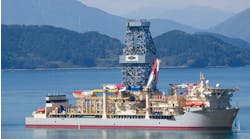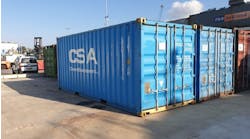Building on subsea technology experience
Jennifer Pallanich Hull
Gulf of Mexico Editor
BHP Billiton, which calls itself "a different kind of wildcatter," has found success in the Gulf of Mexico by staying within basins that have significant or potentially significant trends.
"We really do wildcat," said Steve Bell, president of exploration and global business development, noting the Australia-based company drills about 25 to 30 exploration and appraisal wells a year globally. "We don't have a drilling program where we're going to drill 50 to 60 wells."
Instead, BHP Billiton focuses on drilling fewer wells that target larger deposits. The rewards of that approach are fewer wells, fewer risks, and bigger finds. The nature of the approach means "what gets drilled in the Gulf of Mexico is the best that we have," Bell said.
Combining prospects, high-quality people, and a willingness to drill has contributed to the company's success in the Gulf, he said.
"You can't find the hydrocarbons unless you keep the drill bit turning to the right," Bell said.
BHP Billiton, which has a long history off Australia of working with subsea completions, knew the technology could work in the Gulf.
"We had experience with subsea," said Bernie Wirth, vice president of global exploration. "We didn't fear it as a technology."
While the subsea tieback is now hailed as a cost-efficient solution for an otherwise uneconomic field, William McHolick, vice president for Americas operations and development, hopes to see the dynamics shift further.
"Getting technologies that will lower the costs of subsea tiebacks will be a breakthrough," he said.
BHP Billiton also brought floating production experience to the Gulf. After seeing a ready market and studying the Gulf's targets and basins, the fiscal terms, and existing infrastructure on the shelf, the company decided to use its development technology experience to pursue the deepwater.
"We saw the deepwater as a natural extension of those capabilities," Wirth said.
BHP, which merged with the mining company Billiton in 2001, acquired a legacy position in the shallow Gulf with the purchases of Energy Reserves Group in 1984 and Monsanto Oil Co. in 1985. These two buys left the Australian company with 400 onshore and shallow offshore properties in the early 1990s. Of those, BHP sold off all but three: West Cameron block 76, which it operates; Green Canyon block 18, in which it holds 25% interest, and the Surubi field in Bolivia. BHP sold the remaining properties to make room for deepwater GoM prospects in its portfolio, Wirth said.
Atwater fold belt includes Atlantis, Mad Dog, Shenzi, and Neptune discoveries.
"It was one of the basins we wanted to be in," he said.
At first, BHP focused on buying up acreage in the Central Gulf, partnering with BP on some of the purchases. The company, which made a large showing in the 1995 and 1996 lease sales, bought into the 1995 Neptune discovery in Atwater Valley block 575. The acquisition brought the independent into the Atwater fold belt.
"The Atwater fold belt has been a very good trend for us," Wirth said.
BHP Billiton is in the thick of an extensive drilling campaign in the western Atwater fold belt, and the company has learned a lot about operating and geology.
BHP Billiton's discoveries in the western Atwater fold belt include Atlantis, Mad Dog, Shenzi, and Neptune in water depths of 4,500-7,100 ft. This year, the independent also announced the Chinook and Cascade discoveries in the Walker Ridge area in 8,200 ft to more than 8,800 ft of water and the Vortex find in the eastern Atwater fold belt in 8,344 ft of water.
"The industry worldwide hasn't pushed out as far into frontiers as the Gulf of Mexico," Bell said. "The Gulf of Mexico's usually the bellwether."
Another GoM play that's been good to BHP Billiton is the Typhoon mini-basin. Typhoon was discovered in 1999, and the play includes Boris, BHP Billiton's first operated field in the deepwater Gulf.
BHP Billiton's non-producing lease interests in the Gulf are 38 operated of 43 held in 0 to 1,500 ft water depth, 71 operated of 115 held in 1,501 ft to 5,000 ft water depth, and 105 operated of 181 held in greater than 5,001 ft water depth, for a total of 214 operated of 339 leases held in the Gulf, as of Sept. 1, 2003.
The GoM "is intended to be a major producing area for the company, and we're on track to make that happen," McHolick said.
BHP Billiton likes what it sees in the Gulf's opportunities, trends, and payoffs. As long as the GoM continues to exhibit those qualities, Wirth said, "We'll continue to play the Gulf."
The company is branching into new plays based on information turned up by the drill bit. Bell expects on-going activity and drilling for large resources to continue. Wirth said if BHP Billiton is going to participate in a play, the company wants to be a top player in it.
"The most important thing we can do worldwide is pick the right basin," Bell said.
The challenge in the deepwater is putting production systems in place to economically develop areas lacking existing infrastructure, Wirth said.
Finding the right, new basin often requires finding large amounts of reserves to fund initial installation of infrastructure, he said. Secondary discoveries can be tied back to those facilities
BHP Billiton's daisy-chain approach seeks plays with a high degree of dependency within the play, so if successful, other opportunities on the play face lower risk levels, Wirth said. BHP Billiton focuses on highly prospective tends that the company can test with a well or two. The trick is identifying the plays and knowing when to stick with it despite a dry hole or two, he added.
"The deepwater play has been a technology-based play in the industry," Wirth said, calling subsalt imaging "a top key that will unlock a tremendous value in the Gulf."
The company is involved in several joint ventures aimed at conquering subsalt imaging.
"If you can't see it, it's difficult to put in a half-a-billion to more than a billion-dollar development," Wirth said.
.
Another technology focus, Bell said, is the high-pressure/high-temperature nature of the deep gas wells on the shelf, which is pushing the limits on existing rigs.
Like many offshore operators in the Gulf, BHP Billiton is returning to the shelf. In the two recent lease sales, BHP Billiton, partnered with Newfield Exploration, snapped up 33 "shallow" leases in the central GoM lease sale in March 2003. BHP Billiton is the apparent high bidder on 33 additional blocks on the shelf, of which 17 are in a partnership with Newfield, in the western GoM, held in August 2003.
The deep gas play is consistent with BHP Billiton's view of the GoM's source rock potential. The next Gulf of Mexico play is going to come from under the current Gulf, Wirth said. It's a "new horizon for the industry," he said. Beyond that, Bell said, the daily challenge is figuring out what will be the next hot play after the Gulf.
Royalty relief for gas production from the shallow water helped draw BHP Billiton's attention back to the shelf, Wirth said, but the company would really like to see the US Minerals Management Service relax its five-year lease term requirements. He said completing seismic and drilling and making deci- sions about a field "all within a five-year term is a very daunting challenge."
null
Experience moves to the Gulf
BHP Billiton already operates other deepwater and shallow-water fields around the world, including the Griffin field in the Carnarvon basin off Western Australia and the Angostura development off Trinidad. In the beginning of its deepwater career in the Gulf, BHP Billiton was content to pair up with an operating partner and influence development choices. The company is now operating many of its latest deepwater discoveries, and the company is focused on making the transition from partner to operator and partner.
"This is a fundamental shift of the company," Bell said.
The company has learned a great deal from its partnerships with other companies, Wirth said. BHP Billiton partners with companies not just for financial reasons but also to establish global relationships, the company said.
"Relationships that work in one basin, in one country, we tend to seek out those relationships elsewhere," Bell said.
The relationships also come into play in quickly bringing near-field finds onstream. BHP Billiton and ChevronTexaco are partners in Typhoon and a series of leases around that field. McHolick said working with the same partner decreases the amount of negotiating necessary in developing and producing the hydrocarbons.
Boris is first wave of BHP Billiton's wedge loading plan
With the expected short field life at Boris, operator BHP Billiton opted to develop Green Canyon block 282 as a subsea development tied back to the Typhoon mini-TLP in Green Canyon block 237. The Boris development is the first in what the Australian company hopes is a series of near-field developments.
"We can create a significant amount of value U that we can generate from nearby opportunities," said William McHolick, vice president for Americas operations and development.
While the company seeks large fields, it makes the most of the smaller fields it finds, as well. Using the subsea approach, McHolick said, the company can economically develop satellite fields as long as a host is in place. In the case of Boris in 2,400 ft of water, BHP Billiton made use of the ChevronTexaco-operated Typhoon mini-TLP 6 mi away by installing a subsea wellhead with a flowline to the TLP. Boris, BHP Billiton's first operated deepwater GoM field, went onstream in February 2003 at more than 15,000 boe/d gross. Boris North went onstream Sept. 17, 2003, going from discovery to production in 13 months. With Boris North, gross daily production from the fields is expected to reach 18,000 b/d and 27 MMcf/d of natural gas, although actual production rates will depend on well performance.
"Working with our partners, we were able to significantly reduce the cycle time by using the exploration well as a producer," said Mike Weill, president of operations and technology for BHP Billiton Petroleum. "The high productivity of the Boris North well, combined with existing production from Typhoon and Boris South, will allow us to maintain the Typhoon facility at capacity for the next several months."
Estimated commercial life of the field is six to eight years. Boris operator BHP Billiton holds 50%, and ChevronTexaco and Noble Energy each hold 25%.
null
McHolick said BHP Billiton can commercialize fields to about one-tenth the size of the host.
The trick to remember, he said, is that these smaller fields tend to play out quickly and the only way to economically use the host is to wedge load, or plan for production depletions by placing other developments onstream as the previous output begins to wane.
"It's a very fast treadmill," McHolick said. "It's not measured in years. It's measured in months."
Another part of wedge loading, he said, is quickly bringing discoveries onstream. BHP Billiton brought Boris South onstream 15 months after discovery, and Boris North went onstream 13 months after discovery. McHolick said the goal is to drop the lag-time to one year for a development to go onstream.
One way BHP Billiton minimizes risk and speeds up development time is by using a multi-disciplinary team at the outset of each project. Employees with backgrounds ranging from exploration to production to marketing crude are all on the team, he said.
BHP Billiton has fully delineated Boris, discovered in October 2001, and is now assessing risks associated with other developments, McHolick said.
While developing finds like Boris, which has reserves of 10-35 MMboe, via the subsea method will turn a tidy profit, he said, the company does not use this income to offset costs associated with drilling riskier wells. Instead, he said, BHP Billiton thoroughly works through all available geophysical data to decrease uncertainty about where opportunities exist.
"To be successful, you've really got to manage risk," McHolick said.







